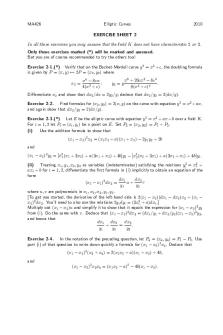Nanomaterials Problem Sheet 2 PDF

| Title | Nanomaterials Problem Sheet 2 |
|---|---|
| Course | Nanomaterials |
| Institution | University of Technology Sydney |
| Pages | 3 |
| File Size | 149.7 KB |
| File Type | |
| Total Downloads | 85 |
| Total Views | 145 |
Summary
Questions and answers from Autumn 2021 Nanomaterials course' second problem sheet....
Description
NANOMATERIALS PROBLEM SHEET 2 MINH T AM L E 13963386 1. Define the Hamaker constant and Debye length of a colloidal solution in less than 100 words. [2 marks] The Hamaker constant is a coefficient value that is used in relating the Van der Waals (VdW) interactive energy to the distance of separation between 2 particles where the interactive force exists independent of the influence of the intervening medium between these interacting particles. VdW force is attractive when A is positive in the equation: A = π 2 x C x p1 x p2 in which p1, p2 are the densities of the interacting particles and C is the coefficient in the interaction. The Debye length measures the electrostatic screening in semiconductor materials, or plasma and colloids. The Debye length is calculated by the reciprocal of kappa (1/kappa), in which kappa is the Debye-Huckel parameter. This measurement in calculating the thickness 1/k around a charged colloidal particle submerged in an electrolyte solution. 2. Provide typical values of the Hamaker constant for Au and SiO2 nanospheres immersed in water. [2 marks] Nanosphere Hamaker constant (J) Gold (Au) 45.5 x 10-20 Silicon Dioxide (SiO2) 6.6 x 10-20
3. Find and report typical values for εr (the relative dielectric permittivity) of liquid H2O at four temperatures between 0 and 200 °C. [2 marks] 0 Temperature ( C) Relative dielectric permittivity (εr) 20 80.35 80 60.80 100 55 200 45
4. Use the provided Excel spreadsheet to calculate the repulsive, attractive, and net interaction energy as a function of distance for (i) two Au nanospheres of 4 nm radius (in water) and (ii) two SiO2 nanospheres of 4 nm radius under the same conditions. Assume the Debye length is 10 nm, the zeta potential is 100 mV, and the water is at room temperature (25°C). Now plot the graphs for the Au and SiO2 cases and comment on the differences and similarities. Which colloid is likely to be more stable and why? [10 marks]
Figure 1: Graph of repulse, attractive and net interactive energy as a function of distance for gold nanospheres
Figure 2: Graph of repulse, attractive and net interactive energy as a function of distance for silicon dioxide (SiO2) nanospheres
The shapes of the graphs for both nanospheres follow similar shapes, including the steep negative drops. This drop occurs when the 2 interacting particles move close enough to each other, and this is when the colloid becomes unstable and collapse. The colloid’s stability depends on the VdW, and electrostatic interactions between the interacting particles. Thus, gold is the more stable type of nanosphere, due to it possessing a higher net interactive energy. 5. Now keeping the other parameters as in question 4, vary the zeta potential and replot the graphs. At what zeta potentials are the two colloids likely to collapse? Why is there a difference between them? Which of the input parameters is the one mostly responsible for this difference? [10 marks] When the zeta potentials are below 100mV, both colloids show signs of instability and likely to collapse, with the silicon dioxide nanosphere collapsing sooner than the gold nanosphere as the zeta potential value is lowered. The main difference between these nanosphere types in this regard is due to gold nanospheres being inherently more stable. 6. Now, for the case of the Au colloid, increase the water temperature to 200°C and repeat your analysis (fix the zeta potential at 100 mV). What effect does raising the temperature have on the stability of the colloid in this case? [4 marks] Changing the temperature weakens the electrostatic interaction, leading to instability. This is because temperature influences the screening length of the electrostatic repulsion. Additionally, changing the temperature may influence the charge on the particles due to changes in dissociation rates of the ionizable surface groups....
Similar Free PDFs

Nanomaterials Problem Sheet 2
- 3 Pages

Nanomaterials Cheat Sheet
- 3 Pages

Problem sheet lecture video 2
- 1 Pages

Problem Sheet
- 15 Pages

Nanomaterials and technology
- 20 Pages

Problem Sheet Matrix
- 1 Pages

Problem Sheet 1
- 3 Pages

MA426 2010-2011 Problem Sheet 2
- 2 Pages

MA321 Problem Sheet - Assignment
- 1 Pages

Problem Sheet 03 - Solutions
- 2 Pages

Problem Sheet 1
- 1 Pages

Problem sheet 3- ans
- 6 Pages

Problem set 9 sheet
- 2 Pages

Problem sheet 5 ans(1)
- 11 Pages
Popular Institutions
- Tinajero National High School - Annex
- Politeknik Caltex Riau
- Yokohama City University
- SGT University
- University of Al-Qadisiyah
- Divine Word College of Vigan
- Techniek College Rotterdam
- Universidade de Santiago
- Universiti Teknologi MARA Cawangan Johor Kampus Pasir Gudang
- Poltekkes Kemenkes Yogyakarta
- Baguio City National High School
- Colegio san marcos
- preparatoria uno
- Centro de Bachillerato Tecnológico Industrial y de Servicios No. 107
- Dalian Maritime University
- Quang Trung Secondary School
- Colegio Tecnológico en Informática
- Corporación Regional de Educación Superior
- Grupo CEDVA
- Dar Al Uloom University
- Centro de Estudios Preuniversitarios de la Universidad Nacional de Ingeniería
- 上智大学
- Aakash International School, Nuna Majara
- San Felipe Neri Catholic School
- Kang Chiao International School - New Taipei City
- Misamis Occidental National High School
- Institución Educativa Escuela Normal Juan Ladrilleros
- Kolehiyo ng Pantukan
- Batanes State College
- Instituto Continental
- Sekolah Menengah Kejuruan Kesehatan Kaltara (Tarakan)
- Colegio de La Inmaculada Concepcion - Cebu

